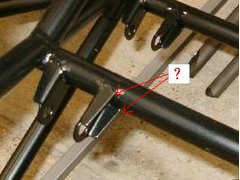Mave
|
| posted on 5/1/06 at 04:11 PM |

|
|
thickness for different style suspension brackets?
I like the suspension brackets in the picture below (CAGED?Stuart Taylor Phoenix). They look very thin though. Could they be 2 mm?!?! For a round tube
chassis is pretty easy to have all those brackets lasercut from 30x30x2 mm tubing, wouldn't it?
Marcel
/HPIM1144_small.jpg)
|
|
|
|
|
dr-fastlane
|
| posted on 5/1/06 at 04:25 PM |

|
|
Donkervoort uses 2 mm plates also for the brackets. But I think it is CrMo (stronger than normal steel) what their use.
Cheers Roy.
[Edited on 5/1/06 by dr-fastlane]
------------------------------
I have not failed once. I have successfully found ways that will not work!
https://www.motor-forum.nl/threads/hardtail-dragstyle-project.343482/
|
|
|
timf
|
| posted on 5/1/06 at 04:28 PM |

|
|
it would be even cheaper to have them laser cut from a flat sheet then folded on a press brake.
|
|
|
Alan B
|
| posted on 5/1/06 at 04:33 PM |

|
|
I'd say they were almost certainly laser/plasma cut and folded and made from good old mild steel.
They will be more than adequate, go and look on a production car at an equivalent bracket, I bet they aren't any thicker
IMO
|
|
|
Mave
|
| posted on 5/1/06 at 04:51 PM |

|
|
Cutting and folding is of course also an option. Would that actually be cheaper? The folding is an extra operation, right?
Hmm, it might also depend on the capabilities of the lasercutter I guess. If it's good at cutting tube all around, then it's an easy job.
They do look nice though.
|
|
|
Alan B
|
| posted on 5/1/06 at 05:05 PM |

|
|
Yep folding is an extra operation.
However, most laser machines are just plain 2D devices, the tube cutting lasers are different (specialised, with extra axes) machines.
Also the tubing would be more expensive than the sheet metal, so I'd say the cut and fold method will be cheapest if someone else is making them
for you.
|
|
|
britishtrident
|
| posted on 5/1/06 at 08:23 PM |

|
|
Potential failure points due to stress concentrations ---- sometimes it dosen't pay to make brackets too stiff, in this case I think the toe of
the weld could be a problem.
 
Rescued attachment brack1.jpg
|
|
|
Syd Bridge
|
| posted on 6/1/06 at 09:03 AM |

|
|
quote:
Originally posted by britishtrident
Potential failure points due to stress concentrations ---- sometimes it dosen't pay to make brackets too stiff, in this case I think the toe
of the weld could be a problem.
The weld 'toe' is the least of your problems. When those break, it will be straight across where the flange ends near the hole. This is by
far the biggest stress concentration point.
Brackets of this type need the flange to run around the entire edge to be safe and effective. Then, you could use 16g metal. Hard learned experience
on the offroadcars.
Anyone see the similar brackets on a Dakar car on tele? Tore a circular bit out at the end. Welds stayed good.
Those brackets above are poorly engineered on many points. The diff mounts could do with some attention as well. Although, they use rubber/poly
bushes, which is a highly desirable thing.
Syd.
Edit.. Just realised it's an 'Indy'. So, for the MK Glee Club and Appreciation Society; Those brackets are perfect, and similar
should be on every car built.  
[Edited on 6/1/06 by Syd Bridge]
|
|
|
NS Dev
|
| posted on 6/1/06 at 10:45 AM |

|
|
it's not mate, it's a stuart taylor pheonix.
There may be flaws in that one but compared to the older st stuff it is great!
Retro RWD is the way forward...........automotive fabrication, car restoration, sheetmetal work, engine conversion
retro car restoration and tuning
|
|
|
britishtrident
|
| posted on 6/1/06 at 02:09 PM |

|
|
quote:
Originally posted by NS Dev
it's not mate, it's a stuart taylor pheonix.
There may be flaws in that one but compared to the older st stuff it is great!
Not just me then
|
|
|









